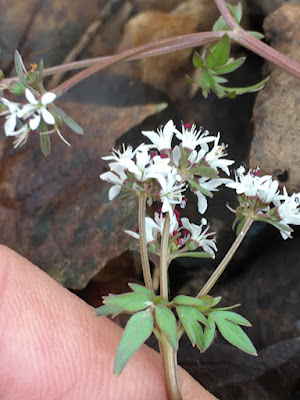#Erigeniabulbosa
Harbinger-of-Spring, salt and pepper later after red anthers turn black
Erigenia bulbosa
Carrot family (Apiaceae)... Etymology. Erigenia: Greek for “born in the spring.” bulbosa: from the Greek bolbos for “bulb, plant with round swelling on an underground stem.
Harbinger-of-Spring is a spring ephemeral short lived, in a brief spell or fever wildflower, above-ground activity fast and rushed each year not waiting for deciduous shade to emerge and the canopy closes creating darkness in the understory.
Harbinger-of-Spring is a spring ephemeral short lived, in a brief spell or fever wildflower, above-ground activity fast and rushed each year not waiting for deciduous shade to emerge and the canopy closes creating darkness in the understory.
And Theia was subject in love to Hyperion and bore great Helius (Sun) and clear Selene (Moon) and Eos (Dawn)
who shines upon all that are on earth and upon the deathless Gods who live in the wide heaven. [375] And Eurybia, bright goddess, was joined in love to Crius and bore great Astraeus, and Pallas, and Perses who also was eminent among all men in wisdom. And Eos bore to Astraeus the strong-hearted winds, brightening Zephyrus, and Boreas, headlong in his course, [380] and Notus,—a goddess mating in love with a god.
And after these Erigeneia1 bare the star Eosphorus (Dawn-bringer), and the gleaming stars with which heaven is crowned. Hesiod Theogony greek Ἠώς Eos is Dawn, a goddess perpetually in love.
who shines upon all that are on earth and upon the deathless Gods who live in the wide heaven. [375] And Eurybia, bright goddess, was joined in love to Crius and bore great Astraeus, and Pallas, and Perses who also was eminent among all men in wisdom. And Eos bore to Astraeus the strong-hearted winds, brightening Zephyrus, and Boreas, headlong in his course, [380] and Notus,—a goddess mating in love with a god.
And after these Erigeneia1 bare the star Eosphorus (Dawn-bringer), and the gleaming stars with which heaven is crowned. Hesiod Theogony greek Ἠώς Eos is Dawn, a goddess perpetually in love.
Shiny offspring
The offspring of the TITANS Hyperion and Thia are those who shine both on earth and heaven, for one of their children is called Helius (Sun), another Selene (Moon), and yet another Eos (Dawn). Eos consorted with Astraeus 1, the son of the Titan Crius 1 and Eurybia 1, daughter of Pontus (Sea) and Gaia (Earth). They gave birth to the WINDS and to the stars, among which Eosphorus. Eos asked Zeus that Tithonus 1 should be deathless and live eternally. But on asking this favor, she forgot to ask youth for him. So at first, they lived as enthusiastic lovers live, but when his hair became grey, Eos grew tired of sleeping with him, and in spite of she cherishing him and nourishing him with ambrosia, Old Age came upon him, and gradually hardening its grip on him, made so that he could not move his limbs nor do anything except babble endlessly. Yet others affirm that she always loved him, and that she never was ashamed of sleeping with and old man, and kiss his hoary hair.
Always in love
”perennial wildflower ¼" across, consisting of 5 narrow white petals, 5 stamens, a divided white style, and no sepals. The anthers of the stamens are initially dark red, but they soon turn black.
Harbinger Erigenia "plants have a slow start to their reproductive phase and may spend 5 or 6 yr in vegetative development before producing their first flowers—often blooming some 6 or 7 yr after germination." This species has two disjunct separated populations, one in the west of the appalachian divide in the basins of the yough, ohio, mon and allegheny rivers and a western population in the south west lower Susquehanna River Valley. The west population has bioregional ties to the ohio and midwest populations while the eastern variety is a flat population.
Harbinger Erigenia "plants have a slow start to their reproductive phase and may spend 5 or 6 yr in vegetative development before producing their first flowers—often blooming some 6 or 7 yr after germination." This species has two disjunct separated populations, one in the west of the appalachian divide in the basins of the yough, ohio, mon and allegheny rivers and a western population in the south west lower Susquehanna River Valley. The west population has bioregional ties to the ohio and midwest populations while the eastern variety is a flat population.
Population Genomics and Conservation of Erigenia bulbosa (Apiaceae), an Edge-of-Range Species in Pennsylvania
Angela J. McDonnell, Cheyenne L. Moore, Scott Schuette, and Christopher T. Martine
International Journal of Plant Sciences 2021 182:5, 344-355












.jpeg)


